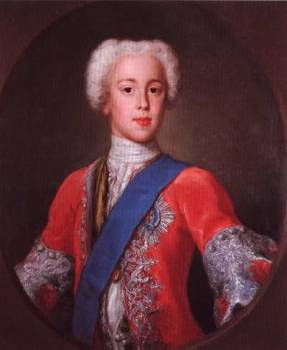History of the Stewarts | Famous Stewarts
If you are a Stewart Society Member please login above to view all of the items in this section. If you want general information on how to research your ancestors and some helpful links - please look in background information.
If you have a specific question you can contact our archivist.

In 1743 the French decided to send an invading force to Britain, led by ´the Young Pretender´, as his enemies called him. The scheme fell through due to stormy weather. The Prince decided to go ahead without French assistance, and he set out for Scotland with only a handful of companions, landing in the Outer Hebrides in July 1745 O.S.
By sheer force of personality he won over the Highland chiefs, captured Perth and declared the Union dissolved. He gathered an army of 5,000, marched to Edinburgh, and defeated a Government force led by Sir John Cope at the Battle of Prestonpans, near Edinburgh in September. His supporters would have been content with that success, but Charles was determined to invade England - knowing that if he didn´t his victory would never stand, and so his army marched south. Not all of the Prince´s supporters were Catholic or Highlanders - some were Episcopalians; others were drawn by the promise of breaking the Union or the Stuart cause, some were English, French or Irish. This was not a war between the Scots and English but rather a rising with more complex roots and reasons that should be looked as part of the series of pan European conflicts that happened at the period. The reasons that the French didn´t help more however much they wanted the Stuarts on the throne had to do with the balance of power throughout Europe.
The Jacobites captured Carlisle but, by the time they reached Derby, the Jacobite Lieutenant-General Lord George Murray and the other commanders were convinced that they could never take London, for George II had not just one army but three ranged against them. Furthermore, there was a disappointing lack of support for Charles amongst the English, for example Manchester provided only a few hundred recruits of poor quality. This was probably due in part to the very harsh punishments meted out on the English Jacobites after the 1715 Uprisings.
Much against the Prince´s will, his supporters persuaded him to turn back at Derby. Pursued by the government forces, the Jacobites won a victory at Falkirk but were finally crushed at the Battle of Culloden in on the 16 of April 1746. Although the Jacobite movement persisted for more than 50 years, the cause was defeated once and for all. The remaining rebels were hunted down, while the power of the clan chiefs was diminished by an Act abolishing heritable jurisdictions.
Charles escaped from the field and after months of being hunted through the Western Highlands, escaped to France, to spend the rest of his life in exile, sinking ever deeper into depression and alcoholism. His late marriage in 1772 to the German Louise of Stolberg was childless and she eventually left him.
After his father´s death, he styled himself ´Charles III´, but by then all hope of a Jacobite restoration had gone. He died in Rome in 1788.
Reference: Scottish National Portrait Gallery

